Plastic Water Bottles, Which Enabled a Drinks Boom, Now Threaten a Crisis (#GotBitcoin?)
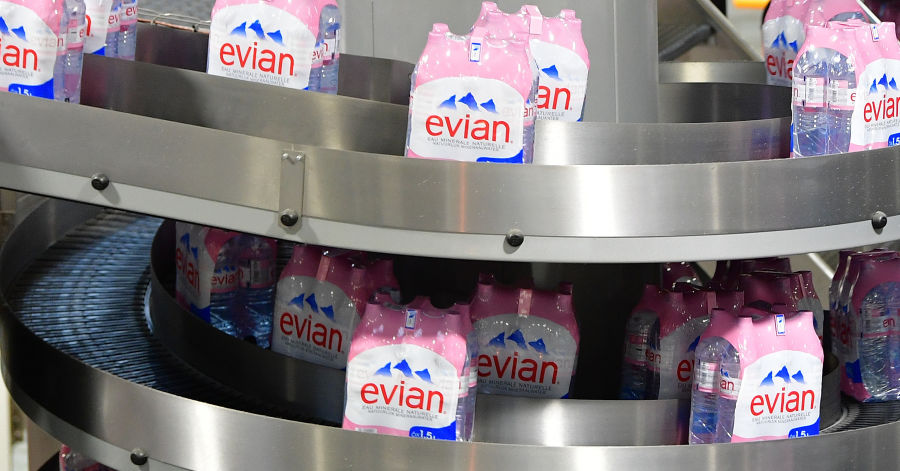
Facing a consumer backlash and stricter regulation, companies are trying to do what’s eluded them for years: make a better bottle. Plastic Water Bottles, Which Enabled A Drinks Boom, Now Threaten A Crisis
Bottled water, which recently dethroned soda as America’s most popular beverage, is facing a crisis.
A consumer backlash against disposable plastic plus new government mandates and bans in places such as zoos and department stores have the world’s biggest bottled-water makers scrambling to find alternatives.
Evian this year pledged to make all its plastic bottles entirely from recycled plastic by 2025, up from 30% today and among the boldest goals in the industry. Executives at parent company Danone SA hope the move will help it regain market share and win over plastic detractors who are already pressuring the makers of straws, bags and coffee cups.
There’s A Big Problem
The industry has tried and failed for years to make a better bottle.
Existing recycling technology needs clean, clear plastic to make new water bottles, and bottled-water companies say low recycling rates and a lack of infrastructure have stymied supply. Danone, for its part, is betting the reputation of its flagship water brand on a new technology that claims to turn old plastic from things like dirty carpets and sticky ketchup bottles into plastic suitable for new water bottles.
“People are really concerned about what’s happening with the packaging,” said Igor Chauvelot, who works on sustainability issues for Danone. “It’s a concern and an opportunity at the same time.”
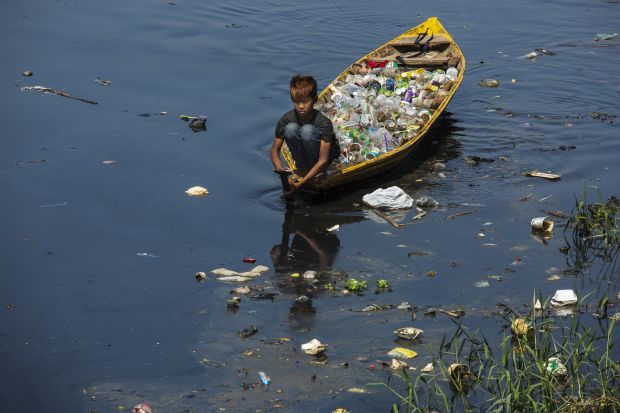
Bottled-water sales have boomed in recent decades amid safety fears about tap water and a shift away from sugary drinks. Between 1994 and 2017, U.S. consumption soared 284% to nearly 42 gallons a year per person, according to Beverage Marketing Corp., a consulting firm.
That growth has been driven by single-serve bottles, which now make up 67% of U.S. sales. Until the early 2000s, water was mainly sold in big jugs for homes and office coolers. More recently, images of bottles overflowing landfills and threatening sea life have soured consumers. Plastic drink bottles are the third most common type of item found washed up on shorelines—behind cigarette butts and food wrappers—according to the Ocean Conservancy, a nonprofit.
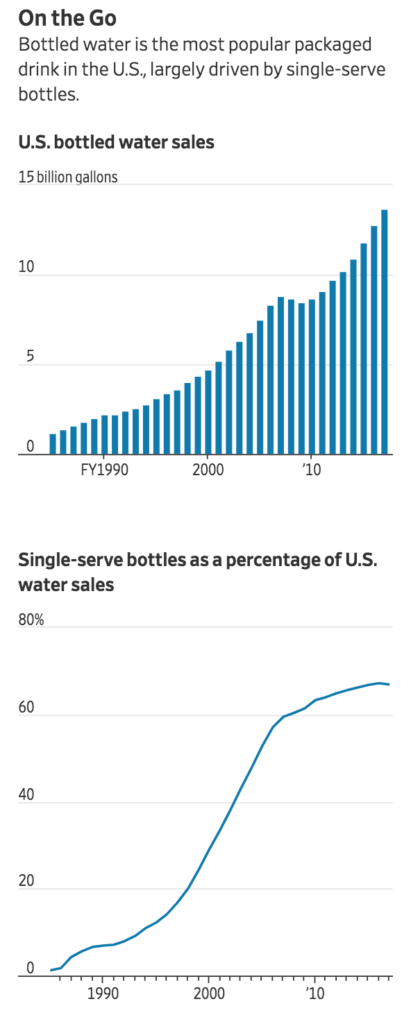
Bottled-water volume growth is forecast to slow this year in both the U.S. and globally, according to research firm Euromonitor. Nestlé SA, the world’s biggest bottled-water maker, in October said its bottled-water volumes for the first nine months of the year declined 0.2%, compared with 2.1% growth a year earlier.
Maura Riggs kicked her bottled-water habit in April after seeing a deluge of news stories and photographs on Twitter about how plastic waste is hurting ocean life. “I told my husband that I don’t want to do this anymore,” said the 37-year-old budget analyst, who for a decade had lugged home 120 bottles every month.
The Indianapolis-based couple fill 16-ounce reusable tumblers with filtered tap water to drink at home and in the car. “It’s cumbersome, maybe a bit, but it’s totally worth it,” said Ms. Riggs.
Offices, department stores, zoos and other public spaces on both sides of the Atlantic have stopped selling bottled water. A string of towns in Massachusetts have banned the sale of small bottles. A proposed bill in New York City would outlaw the sale of single use plastic bottles in city parks, golf courses and beaches.
The European Parliament in October backed laws to make member states collect 90% of plastic bottles for recycling by 2025. Cities including London and Berlin have encouraged local shops and cafes to display stickers saying they will fill reusable water bottles free. Mumbai this year banned water being sold in small bottles.
Companies Are Searching For Answers
PepsiCo Inc. in August agreed to buy SodaStream—a maker of countertop machines that carbonate tap water—saying the $3.2 billion deal would help it go “beyond the bottle.” Pepsi also now sells reusable water bottles that come with capsules to add flavors, and is testing stations in the U.S. that dispense Aquafina-branded water in different flavors.
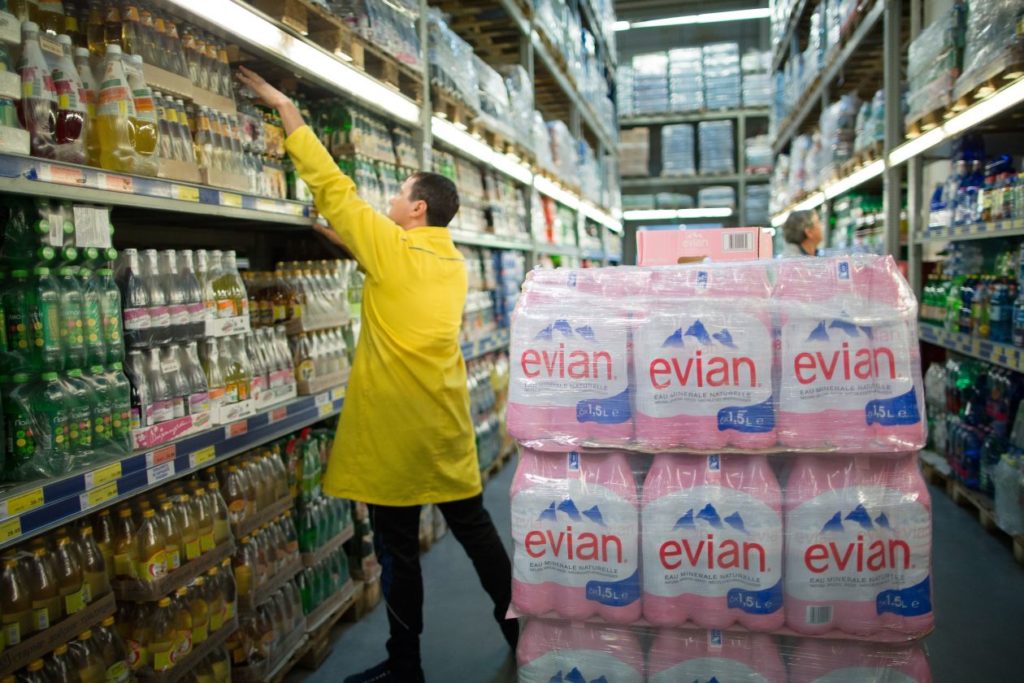
Poland Spring-owner Nestlé is rolling out glass and aluminum packaging for some brands and researching ways to make all its packaging recyclable or reusable by 2025.
“The importance of this now has sunk in,” said Beverage Marketing Corp.’s Chairman Michael Bellas, who has followed the drinks industry for the past 46 years. “It’s the total broadened awareness of the environment, especially with millennials.”
Still, executives aren’t looking to get rid of plastic, which is cheap, robust and lightweight. A former Nestlé executive said the company’s internal research showed consumers were unlikely to take to boxed water. Glass bottles, meanwhile, break easily and are expensive to transport because they are heavy.
“It’s tempting to romanticize a world without packaging,” Coca-Cola Co. CEO James Quincey wrote in a blog post this year. “Modern food and beverage containers help reduce food spoilage and waste. They limit the spread of disease.”
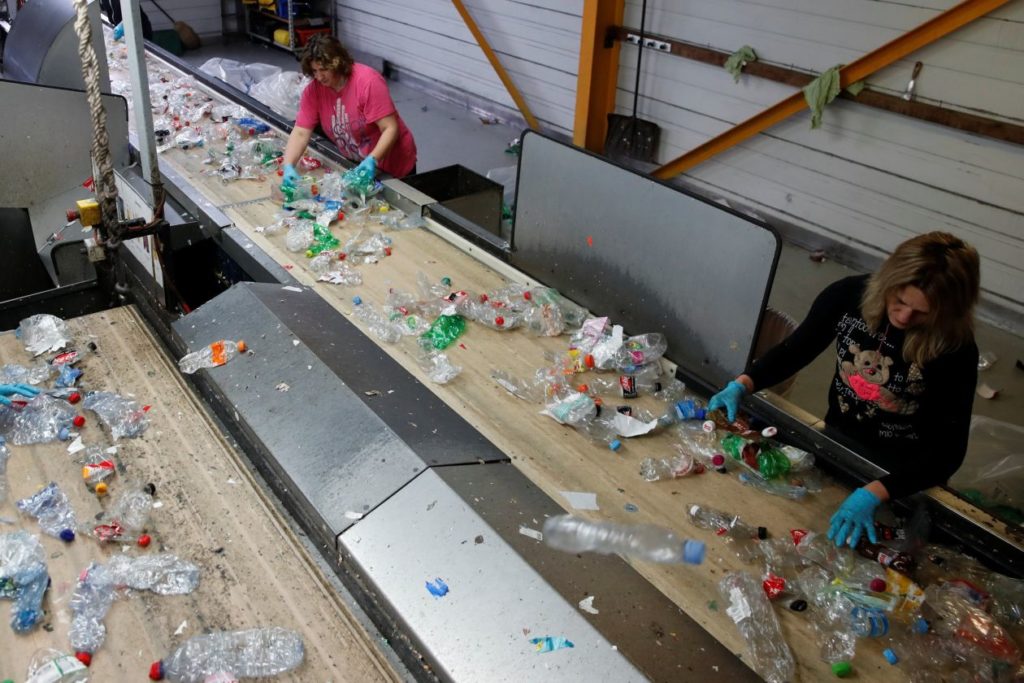
For the bottled-water industry, the challenge has been to find a recycled product that meets regulatory standards for food-grade PET plastic, which is used in bottles. So far, the industry has relied on a recycling method that washes, chops and melts waste plastic to create resin. Most of it gets turned into clothes and carpets since plastic loses some of its structural properties and becomes discolored with each recycle, diminishing the appeal to bottled-water makers.
Cedric Dever, at the time an Evian packaging manager, learned in 2016 of a new process that claimed to turn a variety of waste plastics into clean, high-quality material. “It seemed to be so magical,” said Mr. Dever, adding he wondered if it was “too good to be true.”
A Montreal-based startup, Loop Industries Inc., had developed a process to break plastic into its base ingredients. The process didn’t use heat or pressure, so contaminants didn’t melt into the plastic and could be filtered out. Daniel Solomita, Loop’s CEO, likened it to disassembling a chocolate cake into its ingredients—sugar, flour, chocolate, eggs and butter—to make a brand new cake.
He said other technologies, in contrast to Loop’s, are limited because they can process far fewer materials into new, bottle-quality plastic. “They’re all fighting for that clean, clear plastic bottle because that’s the only type of feedstock they can use,” he said. “We don’t have supply constraints.”
Mr. Solomita said he first began searching for ways to make waste plastic usable after leading a project to remove 40 million pounds of nylon fiber mixed with dirt from a landfill.
Mr. Dever and Danone executives had the process tested at Loop’s pilot plant—bringing their own waste plastic secretly tagged with a tracer to make sure that the returned samples were of the same material.
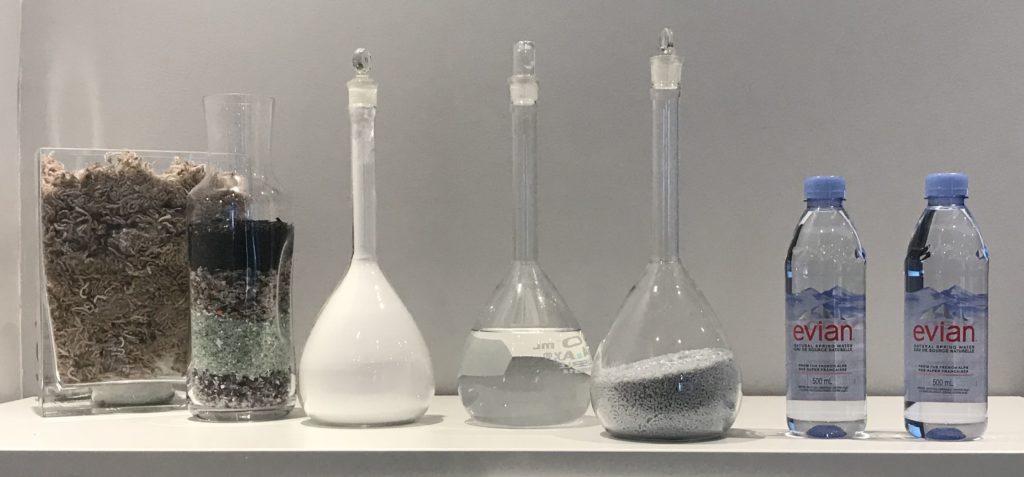
They had the tests repeated with different types of waste, including carpet fibers and colored plastic. “We tried to stretch to the max the Loop technology by giving them materials we couldn’t use,” said Frederic Jouin, R&D packaging head for Danone Waters.
The resulting samples, once turned into bottles in France, met Danone’s quality standards.
Loop has yet to scale up its technology, and the company said its production plant won’t be ready until 2020. Loop shares, listed on Nasdaq, are down about 50% this year. Danone said it has confidence in Loop’s technology. Loop has also signed supply deals with Pepsi and Coca-Cola’s European bottler.
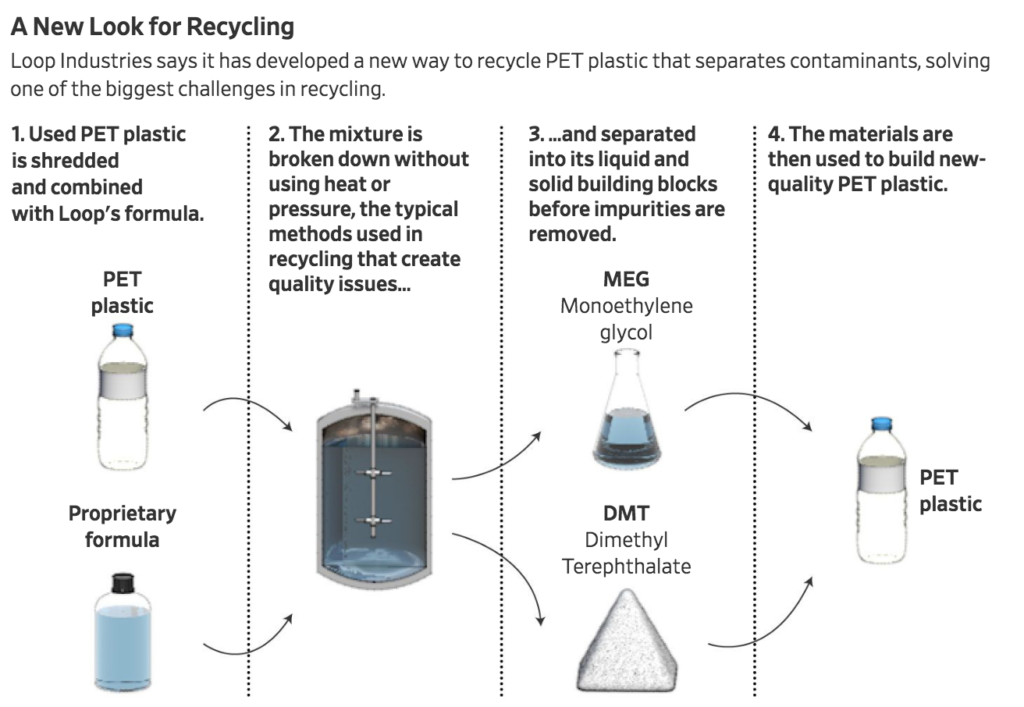
Less than a third of PET bottles sold in the U.S. are collected for recycling, with less than 1% processed into food-grade plastic, according to Pepsi, one of the biggest buyers. The bottled-water industry says using more recycled plastic in bottles will incentivize collection of old bottles by giving them value. Companies are launching new marketing campaigns, employing more waste pickers and backing new bottle deposit schemes to encourage recycling.
Danone, like much of the industry, has made promises about using recycled material before only to break them. A decade ago it pledged to use 50% recycled plastic in its water bottles by 2009. The very next year it slashed that target to between 20%-30% by 2011. Today, just 14% of the plastic in the bottles across its brands is recycled material.
Other companies’ efforts to broadly use recycled plastic have also stagnated, even though a few produce 100% recycled PET bottles for brands limited to certain countries or sizes. Nestlé’s plastic water bottles use just 5% recycled material in Europe and 7% in the U.S., while Coca-Cola’s use 10%. Pepsi says it uses 9% in bottles in the U.S. and 16% in Europe.
In 2009, Nestlé launched a bottle made of 25% recycled plastic at Whole Foods but later scrapped it. Danone yanked a Volvic bottle made partly from biobased plastic after consumers paid little attention.
Danone gained confidence after consumers in Argentina in 2015 took to a new bottle made of 50% recycled plastic. Advertisements for the Villavicencio brand featured a popular actor explaining how waste bottles are turned into new ones.
Danone sought to be more ambitious with Evian. “Once we put ourselves in consumers’ shoes we realized 25% or 50% doesn’t make a lot of sense,” said Mr. Chauvelot. “What makes sense to the consumer is 100%.”
All Evian’s water is bottled at a single plant on the outskirts of the tranquil town that shares its name on the shores of Lake Geneva. The brand traces its roots back to 1789 when a French count claimed drinking the town’s water cured his kidney disease.
Evian rolled out in the U.S. in the late 1970s, wooing health-conscious Americans with splashy ads playing up the benefits of hydration. By 1999, helped by clever product placement among models and athletes, Evian was the world’s No. 1 bottled-water brand and the U.S. market leader by sales, according to company filings.
Then a flood of competitors, including mass-market offerings such as Coca-Cola’s Dasani and upscale brands such as Fiji, grabbed share. Evian’s U.S. volumes plunged to 29 million gallons last year from 69 million in 2000, according to Beverage Marketing Corp. Its global market share by volume last year was 0.5% according to Euromonitor.
Danone said marketing about the recycling plan helped Evian sales climb 6% in the first nine months of the year.
At Evian’s giant bottling plant on the French-Swiss border, five trucks of virgin and recycled PET arrive each day. About 100 metric tons of rice-like plastic pellets pour into towering metal silos.
After being quality checked, the pellets are heated and molded into test-tube shapes. Robots move these to sealed rooms where they are blown into bottles, filled with water and capped. The fastest of 10 lines can produce 72,000 bottles an hour. The plant has the capacity to make two billion bottles a year.
To hit its recycling goal, Evian hopes to take deliveries of Loop-branded plastics at the factory by 2020. It is also talking to other potential suppliers. “We have a backup plan for sure,” said Mr. Jouin, Danone’s packaging head.
Related Article:
Carolyn’s Natural Organic Handmade Soap

Leave a Reply
You must be logged in to post a comment.